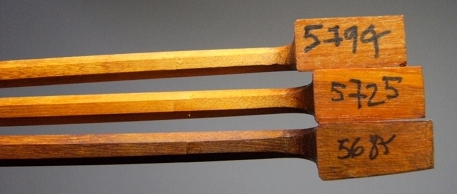THE SOUND VELOCITY
Before speaking about “The sound velocity” I take the opportunity to announce that Atelier d'Archeterie has finally found its own rosin, born from the cooperation between us and Melos. You will find all details at the bottom of this article, but first of all we deal with "The sound velocity".

THE SOUND VELOCITY
The choice of the material to be used, in bowmaking as well as in any other building technique, has a great importance for a proper result. As already told, no scientific method was in force until the end of the ‘70es of the past century so there was no possibility to get reliable information about the used material; in this period a “weird genius” from Romagna appeared in this world.

Wood speed expressed in meter per second
The nice guy from Romagna I am speaking about is Maestro Giovanni Lucchi: by the end of the '70es, after having moved from Bologna to Cremona to establish a bowmaking school, he tried hardly to discover the reason why some sticks that he considered as excellent didn’t play while other ones, not at all ranked as good ones, gave very satisfactory result. He discussed this problem with a friend that was both engineer as a job and bowmaker as a hobby so he got acquainted with a test that was used in those days in the house building field. This test put two parameters into relation, even if they were totally disregarded by people that dealt with physic-acoustic property of the musical instruments: space and time.
It is told that Stradivarius used a very particular method to select his woods. He placed a pitch pine trunk on two easels, on one side there was his assistant with a hammer and Stradivarius was exactly at the opposite side. The assistant beat the trunk with the hammer while Stradivarius listened to the emitted tone and above all how long was the time needed to the sound to pass throughout the wood. The great maestro carried out these tests empirically, i.e. basing the results of the sound transmission upon his own sensations. In any case, judging from his masterpieces, he did a nice job indeed!
Maestro Lucchi was more and more convinced that the research could led to a positive result and he understood that he just needed a device allowing him to change a simple intuition into a scientific and reliable parameter. His friend, the engineer, suggested him what he was looking for : ultra sounds !
Ultrasounds are successfully used since long in different applications such as building, aeronautic etc. putting the parameters of space and time into relation. Every material , water, air, steel owns a different capability to transport sound and our ear can catch all of them in every day’s life.
We take the three above mentioned materials as an example. May be it has happened to you sometimes to stroke a steel tube filled with water, the sound that came out was a sort of “wan wan wan” This strange effect may be simply explained: the three materials have very different sound propagations so the sound emitted by water, steel and air will arrive in different times, giving place to such a phenomenon.
To know the sound speed of a material it is sufficient to place two ultrasonic leads at both ends of the sample to be examined. The first launches an impulse, which is received by the second. The impulse takes naturally a certain time to cross the sample, so correlating these parameters with the length that the impetus took to go through, you get exactly the sound speed propagation.

Ultrasound tester
Sound velocity parameter, that is obviously expressed in meters per second (m/s) is considered as absolute and undeniable by any bowmaker since 35 years. Pernambuco wood is now sold all over the world keeping as reference the so called “Lucchi’s number”. The reason of such importance is that the more the fibers are in tension, the quickest they can transmit sound. A higher tension means a “high resonance frequency”
The reason of the importance of a high resonance frequency will be the topic of next week.
Now, as promised : Atelier d'Archeterie - Melos Rosin

I had already had this idea last year, lead by the excellent quality of the product I decided to contact Mr. Christos Sykiotis, owner of Melos to know if it were possible to start a cooperation. So, I did it and Christos put his experience and skill at my disposal so we finally received the present of having our own rosin.
It is available for Violin in two different textures: Light and Dark. The first one is recommended for summer time, the second one is a softer version for winter .
Viola Dark, Violoncello Dark and Double Bass Dark.
This rosin is soft and silky on the string and practically it doesn't make any powder deposits.
Atelier d'Archeterie Rosin is sold at Euro 14.50 and can be ordered sending an email request.
So long
Paolo.
|